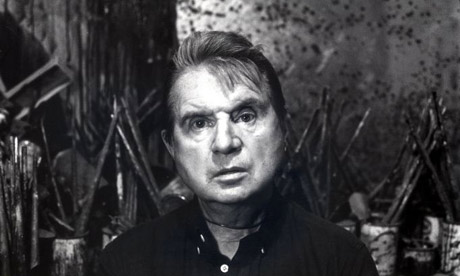Demons and beefcake – the other side of Francis Bacon
Charlotte Higgins, chief arts writer

Francis Bacon had his right eye sewn back in place after he was thrown through a window by lover Peter Lacy. Photograph: Jane Bown
The territories of Francis Bacon‘s soul have been explored widely; they have been the subject of a film, books and endless speculation. But the senior art historian John Richardson – who, at 85, is working on the last volume of his acclaimed biography of Picasso, and who knew Bacon from his 20s – has now laid down his views and recollections of Bacon, amounting to a reappraisal of his life and work.
Writing in the forthcoming issue of the New York Review of Books, Richardson argues that Bacon’s sado-masochistic relationships lay at the heart of his best work, but with terrible consequences for his lover George Dyer, whose fragile mental state Richardson attributes to Bacon’s endless “goading”.
Having provoked Dyer into “a state of psychic meltdown” he “would exorcise his guilt and rage and remorse in images of Dyer aimed, as he said, at the nervous system”. This “goading” resulted in Dyer’s suicide, writes Richardson.
An earlier relationship, with Peter Lacy, was violent to the extent that “he hurled Bacon through a plate glass window. His face was so damaged that his right eye had to be sewn back into place”.
Bacon’s art went rapidly downhill when sado-masochism ceased to be a part of his life, argues Richardson, who describes the “angst-free, soft-porn glow” of his later work.
Richardson, who has hitherto held back from revealing his full memories of Bacon since the artist’s death in 1992, also pours scorn on critics, such as the late David Sylvester, who attempted to defend the self-taught Bacon’s “inability to draw”. He calls the celebrated Screaming Popes series “either magnificent flukes or near-total disasters….”
